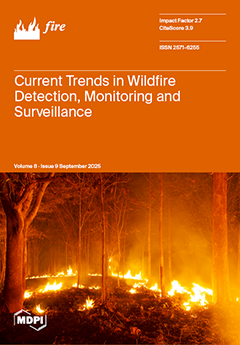Background: Rural fires represent a significant environmental and socioeconomic challenge in Mediterranean regions, particularly in Portugal, which experiences some of the highest fire incidences in Europe. Understanding the temporal evolution of fire occurrences and their relationship with climatic parameters is crucial for developing
[...] Read more.
Background: Rural fires represent a significant environmental and socioeconomic challenge in Mediterranean regions, particularly in Portugal, which experiences some of the highest fire incidences in Europe. Understanding the temporal evolution of fire occurrences and their relationship with climatic parameters is crucial for developing effective fire management strategies and adapting to climate change impacts. This study aims to analyze the evolution of rural fire occurrences in Guimarães, northern Portugal, during the period 1980–2020, and to investigate their relationship with climatic parameters, specifically temperature and precipitation patterns. Methods: We analyzed a comprehensive dataset of rural fire occurrences and burnt areas in the Guimarães municipality from 1980 to 2020, along with corresponding climatic data including mean annual temperature and total annual precipitation. Statistical analyses included descriptive statistics, Mann–Kendall trend analysis, Pearson and Spearman correlation analyses, and multiple linear regression modeling. The relationships between fire variables and climatic parameters were examined using both parametric and non-parametric approaches. Results: The analysis revealed significant temporal trends and climate–fire relationships. Mean annual temperature showed a statistically significant increasing trend (Mann–Kendall Z = 3.055,
p = 0.002) with a Sen’s slope of 0.032 °C/year, representing approximately 1.3 °C warming over the 40-year period. Rural fire occurrences demonstrated a positive correlation with mean temperature (Pearson r = 0.459,
p = 0.003; Spearman ρ = 0.453,
p = 0.003), while total burnt area also showed significant positive correlation with temperature (Pearson r = 0.426,
p = 0.005; Spearman ρ = 0.466,
p = 0.002). Precipitation showed no significant correlation with fire variables. Multiple regression models explained 23.1% of the variance in fire occurrences and 18.3% of the variance in burnt area, with temperature being the primary climatic predictor. Conclusions: The study provides evidence of a significant warming trend in Guimarães over the past four decades, which is positively associated with increased rural fire activity. The consistent relationship between temperature and fire variables suggests that continued climate warming may lead to increased fire risk in the region. These findings have important implications for fire management strategies and climate adaptation planning in northern Portugal.
Full article





